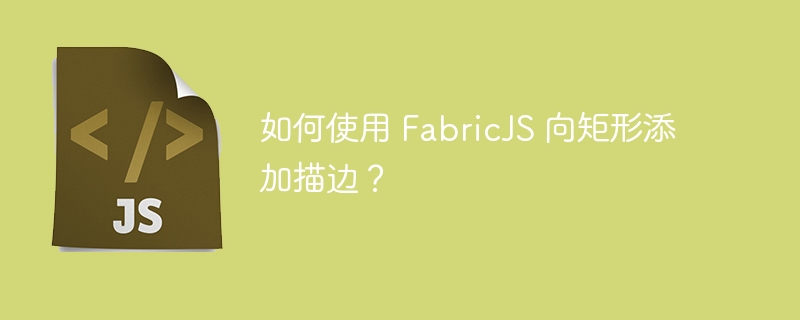

In this tutorial, we will learn how to add a stroke to a rectangle using FabricJS. Rectangle is one of the various shapes provided by FabricJS. In order to create a rectangle, we must create an instance of the Fabric.Rect class and add it to the canvas.
Our rectangular object can be customized in many ways, such as changing its dimensions, adding a background color, or changing the color of the lines drawn around the object. We can do this by using the Stroke attribute.
new fabric.Rect({ stroke : String }: Object)Options (optional) - This parameter is a ## that provides additional customization #Object to our rectangle. Using this parameter, you can change the color, cursor, stroke width, and many other properties associated with the object for which Stroke is a property.
Stroke - This property accepts a String and identifies the object The color of the border.
Pass the stroke as a key with a hex value
Let Let's look at a code example to see how a rectangular object displays when using thelines property. Hexadecimal color codes begin with "#" followed by a six-digit number representing the color. In this case, we used "#000080", which is navy blue.
<!DOCTYPE html>
<html>
<head>
<!-- Adding the Fabric JS Library-->
<script src="https://cdnjs.cloudflare.com/ajax/libs/fabric.js/510/fabric.min.js"></script>
</head>
<body>
<h2>Passing stroke as key with a hexadecimal value</h2>
<p>You can see the navy blue border around the rectangle</p>
<canvas id="canvas"></canvas>
<script>
// Initiate a canvas instance
var canvas = new fabric.Canvas("canvas");
canvas.setWidth(document.body.scrollWidth);
canvas.setHeight(250);
// Initiate a rectangle object
var rect = new fabric.Rect({
left: 55,
top: 70,
width: 170,
height: 70,
fill: "#f4f0ec",
stroke: "#000080",
strokeWidth: 9,
});
// Add it to the canvas
canvas.add(rect);
</script>
</body>
</html>Pass rgba value to lines attribute
In this example we will see how to The stroke attribute is assigned an "rgba" value. Instead of hexadecimal color codes we can useRGBA values which stand for: red, green, blue and alpha. The alpha parameter specifies the opacity of the color. In this example we used the rgba value (0,0,128,0.8) which is navy blue with an opacity of 0.8.
<!DOCTYPE html>
<html>
<head>
<!-- Adding the Fabric JS Library-->
<script src="https://cdnjs.cloudflare.com/ajax/libs/fabric.js/510/fabric.min.js"></script>
</head>
<body>
<h2>Passing an rgba value to the stroke property</h2>
<p>You can see the colour added using rgba to the rectangle's stroke</p>
<canvas id="canvas"></canvas>
<script>
// Initiate a canvas instance
var canvas = new fabric.Canvas("canvas");
canvas.setWidth(document.body.scrollWidth);
canvas.setHeight(250);
// Initiate a rectangle object
var rect = new fabric.Rect({
left: 55,
top: 70,
width: 170,
height: 70,
fill: "#f4f0ec",
stroke: "rgba(0,0,128,0.8)",
strokeWidth: 9,
});
// Add it to the canvas
canvas.add(rect);
</script>
</body>
</html>The above is the detailed content of How to add a stroke to a rectangle using FabricJS?. For more information, please follow other related articles on the PHP Chinese website!
 How to make charts and data analysis charts in PPT
How to make charts and data analysis charts in PPT
 Android voice playback function implementation method
Android voice playback function implementation method
 AC contactor use
AC contactor use
 The difference between vscode and visual studio
The difference between vscode and visual studio
 The difference between Java and Java
The difference between Java and Java
 Introduction to hard disk interface types
Introduction to hard disk interface types
 nagios configuration method
nagios configuration method
 How to delete a folder in linux
How to delete a folder in linux




